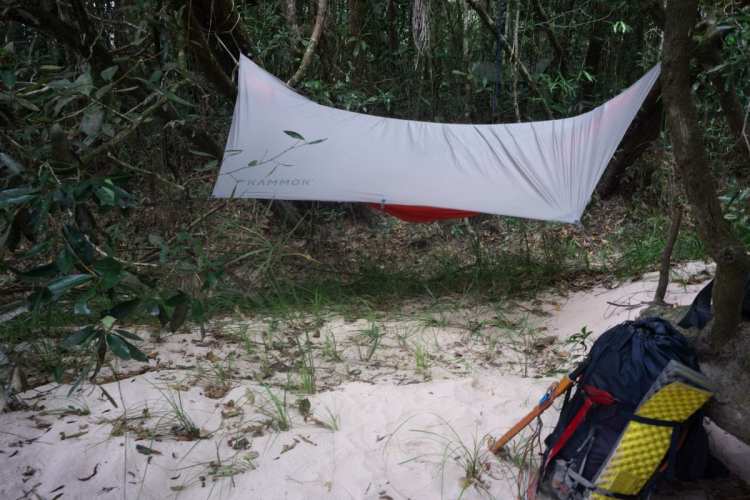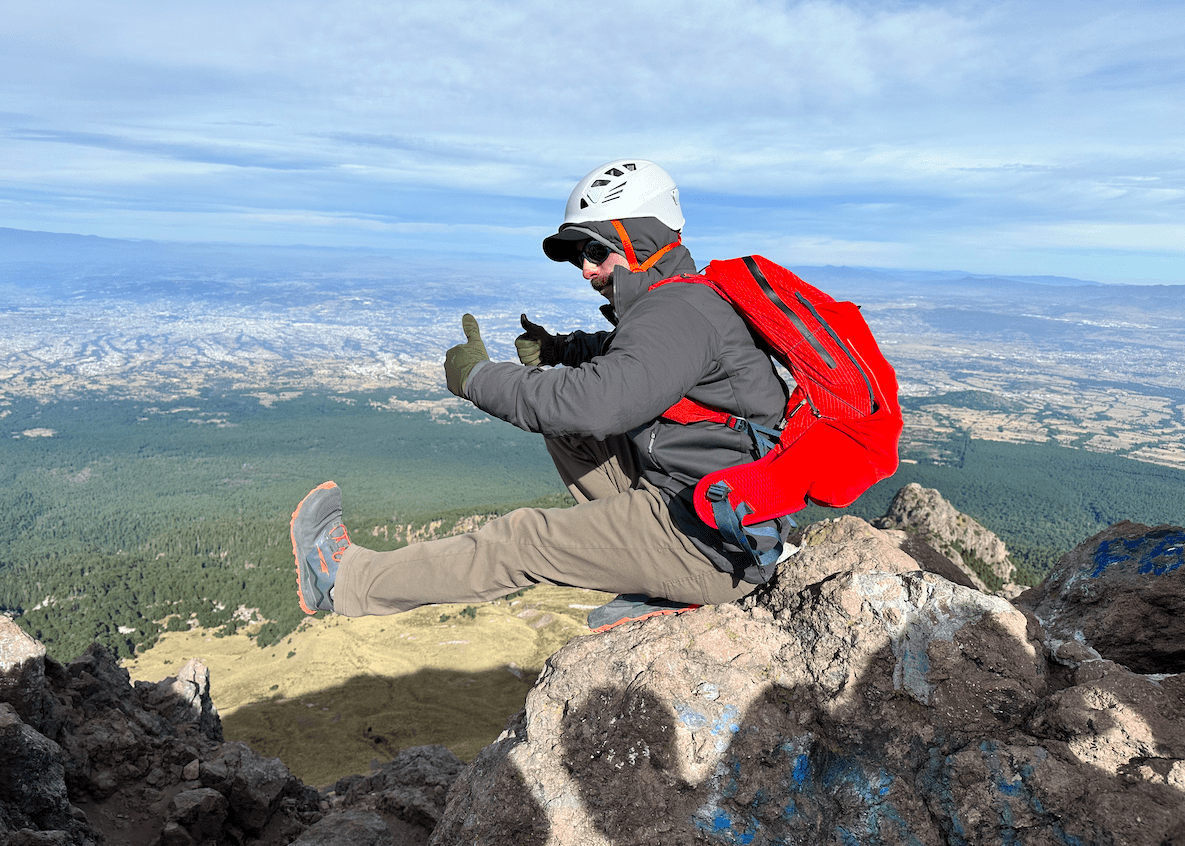Kammok Mantis Ultralight Hammock Review From the Amazon

This April I joined a 3-week river expedition in the Colombian Amazon. We would be crossing a remote terrain of the highland rainforest, on foot and with pack-rafts, and camping in the thick forest every night. Hammocks being the sleeping system of choice in the rainforest – leaf-cutter ants have been known to munch through tents and eat the clothing off people sleeping on the ground – it was the perfect chance to thoroughly test this hammock.
Our expedition consisted of 7 people and 7 different hammocks, so I got to observe the different designs. My main impression is this hammock is ‘fully-featured’ in the best sense. The Mantis UL has some thoughtful additions that some other hammocks lack, and none of them are gimmicks – I used them during the course of the expedition.
I tested the Kammok Mantis Ultralight hammock ($259); it weighs 2 lb 3 oz or just under 2 lb without the stakes and straps. This hammock is essentially the same design as it’s heavier brother, the 2 lb 12 oz Mantis ($229), but is constructed of 20 denier nylon instead of 40 denier nylon. The Mantis is rated to 500 lb, while the UL version is rated to 300 lb. The features I describe here (excepting weight) will apply to both models.

Setup: neat and contained
Most hammocks come with a stuff sack; the Mantis has a stuff-sack that’s integrated into the top-line, and this makes set-up easy. Once you have your trees tied off at head height, simply clip the external carabiner to one tree and pull the hammock out of the stuff sack as you walk across to the other tree. This functionality works the same way when you take the hammock down: simply un-clip the side with the stuff sack and stuff the hammock as you walk across to the other tree. No fuss.
This is very handy in the jungle – we had to literally hack out our hammock spots with machetes each night, so there was always a collection of vines, spiky plants, and severed branches underneath that could snag a large piece of fabric. Deploying and stowing Mantis was quick and snag-free. The stuff sack is also waterproof, with a roll-top closure, which is great for keeping your sleeping shelter dry in rainy environments or on boating trips.
This hammock comes with burly 10-foot webbing straps that are wide to distribute force kindly on tree bark and taper to a daisy-chain end so you can really easily adjust the hammock’s span width. On the expedition I used nylon cord we had for climbing, with a trucker’s hitch. The nice thing about hammocks is that you can use anything on hand to hang them.

Rain fly: easy to tension and ready for serious storms
The Mantis is not unique among hammocks in having a separate rain fly, however, it’s fly is very well designed. First of all, a separate rain fly is critical for camping in rainstorms; in fact, it makes set-up much nicer than with a traditional tent. You can string up the rain fly first, well above your head, and then have a totally dry space to hang out, unpack your bag, and set up your hammock. One night we made camp in the jungle during a verified fire-hose cloudburst, where the rain was so hard that it was hard to look around even under the forest canopy. I was still able to get my rain fly up and then get my hammock and sleeping bag laid out without a drop of water on them. That’s pretty slick.
There are a few subtleties that make the Mantis rain fly extra nice… for one, it’s super light (13 oz and wads up about the size of an orange). It’s sewn into a catenary curve, so it can be pulled tight at a variety of angles (rectangular tarps are much more sensitive to the angle of the various guy-lines and are tricky to get tight). It also has nifty mechanical cinches on each guy-line, so you can quickly tighten and loosen it to get the shape right without relying on knots. While this feature makes the biggest difference in freezing environments (frozen taut-line hitch anyone?), I appreciated the speed and simplicity of the system.
An added bonus: the cinch on the ridge guy-lines, while light aluminum, is actually heavy enough to get a bit of a swing going so you can whip the guy-line around a high tree trunk without climbing up there. Since you ideally want to get the rain fly guy-lines a bit higher than the hammock guy-lines, this is actually really handy.
Leaving no details un-noticed, Kammok provided guy-lines with reflective thread – super useful for finding your hammock at night in the jungle. The hammock also comes with six light aluminum tent stakes that stow conveniently on the outside of the stuff sack. While not totally necessary (you can usually find rocks, sticks, roots, tree trunks, etc.), the stakes are quick and efficient – I used them almost every night.

Comfort and nifty extras
There’s a trend in modern hammocks to include guy-points on the sides of the hammock; this helps pull the hammock out laterally and prevents the ‘collapsing’ feeling some people experience as they sag into a low-slung hammock. The Mantis includes these attachments and two elastic cords to guy the sides out (elastic is nice so you don’t get jerked as you move in the night). I found this hammock to be really comfortable with these in use, and I could also sleep diagonally in more of a ‘traditional’ setup. You can enter this hammock through a full-length zipper on either side – surprisingly helpful in places where one side is hard to access or blocked by thick foliage.
The bug net is well constructed and worked in the Amazon, so it should work anywhere. The side guy-lines help pull it away from your face and provide some more air space. There are also two pockets in the bug net that are handy for stowing a book, headlamp, etc. when you fall asleep – they are only on one end, so you need to note which is the ‘head’ end of the hammock when you set it up. If the bugs are down and you want to air out, the bug net rolls up and stows nicely to let the breeze in.
This hammock has a lot of space inside. It doesn’t feel restrictive and has space for extra clothing and such by your side, by your feet, or hanging from the top-line. Two people can fit inside for hanging out, although this arrangement probably wouldn’t be comfortable for sleeping.
Bottom line: a ‘Cadillac’ hammock that’s lightweight too
My other team-mates on the expedition were jealous: this hammock is not only dressed out with nice features but is lighter too. I carried the Mantis Ultralight at about 2 pounds; I brought the stakes but used nylon cord I had anyway for the expedition instead of the provided straps. Keys to the Mantis’ weight savings are the integrated bug net and very light materials. By comparison, the Eno OneLink shelter ($220) my buddy brought weighs 4.5 lb, over twice the weight. The Nemo Tetrapod ($250) is probably the most similar to the Mantis UL; it weighs 2 lb 7 oz and also has an integrated bug net.
This is the best hammock I’ve ever tried. It was perfect for a rainforest expedition, and I’d bring it for summer backpacking and bike-packing too.
Shop the Kammok Mantis kit here.

See more about the Mantis here.
Drew Thayer









Leave a Reply